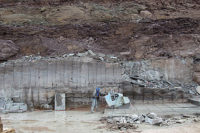Our cover story features the Miller Outdoor Theatre in Houston's Hermann Park (page 46). Originally designed by William Ward Watkin in 1921, and then re-built during the 1960s, the theatre recently underwent a major renovation. And this work not only expanded the theatre's amenities, but it also brought its aesthetics to a national level. The new design utilizes Minnesota Glacier Buff limestone and African Red granite as predominant elements for the exterior, and the result was a multi-award-winning facility for the residents of Houston.
While the Miller Theatre expanded an existing space, the Historic Arkansas Riverwalk Project (HARP) literally re-created the classical riverside environment of Pueblo, CO (page 56). This project re-channeled the Arkansas River back through the town, and created a focal point for the community. Natural stone was an integral part of the project, as it was used in every aspect of construction - from creating the new riverbed to devising structural elements such as bridges, and even pavement for walking and bicycle paths. And with a nod toward the historical significance of the project, stone from the original river bed was used for vertical elements.
While the Miller Theatre and the Historic Arkansas Riverwalk Project are examples of new construction adding to the existing environment, our conservation projects in this issue demonstrate the curative aspect of the sector. At Loyola University's Skyscraper Building in Chicago, the ornate limestone exterior was meticulously restored (page 76). After decades of wear from the harsh Chicago winters, the limestone was suffering from severe displacement due to corrosion of the supporting steel. The restoration effort by Schoengart Associates, Inc. not only addressed the problems, but it also planned for the longevity of the structure for years to come. Work included contemporary water management details such as mastic bond flashing consisting of an asphalt rubberized polyethylene membrane with a termination bar, stainless steel drips and chord weeps. Additionally, approximately one full mile of steel shelf angles were removed, and new galvanized steel was set in their place.
Finally, at Kansas University's Spooner Hall, the red sandstone portico was in such a state of decay that it was taken down and reassembled piece by piece (page 84). And because the existing stone was no longer being quarried, the construction crew came up with an innovative method of salvaging material. Pieces of red sandstone cored from the centers of the original stones were kept and reworked to replace others that were damaged beyond repair.
The innovation of architects, masons and other professions in the stone industry continue to demonstrate that the craftsmanship of the past will remain well into the future.


